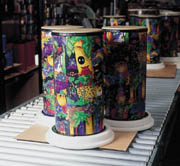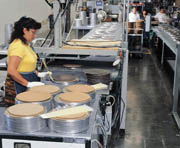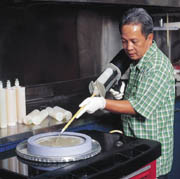
When Remo was founded in 1957, it transformed an important segment of the musical products industry by inventing the synthetic drumhead. The company's founder, Remo Belli, who was inspired by aerospace industry glue and resin applications, started to experiment with emerging materials and techniques. From this beginning, he revolutionized percussion by developing the first synthetic drumhead, a solution that proved to be easy to manufacture, weather-resistant and more durable. Remo's synthetic drumhead has contributed significantly to the success of thousands of drummers and bands worldwide, and has laid the foundation for Remo's own success and its leadership position in advancing acoustical authenticity and technically superior drumheads.

Remo constructs its technologically advanced drumheads by gluing a Mylar-composition "head" to a channeled metal ring, called a "flesh hoop", using a STATOMIXTM static mixer from ConProTec Inc., Salem, NH, to distribute the adhesive that bonds the two elements. The disposable static mixer is used to apply the adhesive for Remo's production operations.
"Remo is known worldwide for the quality and excellence of its percussion products," said Richard Wilson, ConProTec technical director. "We are pleased that ConProTec products have played an important role in helping Remo to achieve this level of global recognition. Remo uses our innovative STATOMIX static mixers to bond dissimilar materials using a metering technology to distribute, dependably mix and apply the adhesive."


"The mixer consists of a series of left- and right-hand helical elements," Wilson said. "When the adhesive is pumped through the mixer, the streams are progressively divided and recombined, resulting in a layering phenomenon."
In addition, the drumhead and trough have numerous patented design elements that contribute to an adhesive's even distribution and penetration. After the gluing process, the completed drumhead is cured for a specified time and then connected to the drum.

Remo also uses ConProTec's MIXPAC hand-held adhesive dispensing system in its research and development operations, and in its custom manufacturing and repair business. For example, some marching bands use drums that have drumheads exceeding 9 feet in diameter. When such drums are constructed or repaired, their large size cannot be accommodated by machines using fixed static mixers. A hand-held adhesive dispensing system vastly expands the range of sizes and types of drumheads that can be easily constructed or repaired.
The MIXPAC system consists of manual or pneumatic dispensers, cartridges and static mixers, all designed to work as an integrated, high-performance, hand-held cartridge dispensing system for two-component adhesives. These are available in 25-490ml capacities and in volumetric ratios of 1:1, 2:1, 3:2, 4:1, and 10:1.
"ConProTec has provided the solutions we need to produce our products and have met every request that we've made. Working with a vendor who can meet these requirements without any problems is music to our ears," Ridgeway said.
For more information, contact ConProTec Inc., 8 Willow St., Salem, NH 03079; phone 603-893-2727; fax 603-893-3737; or visit http://www.mixpac.com .